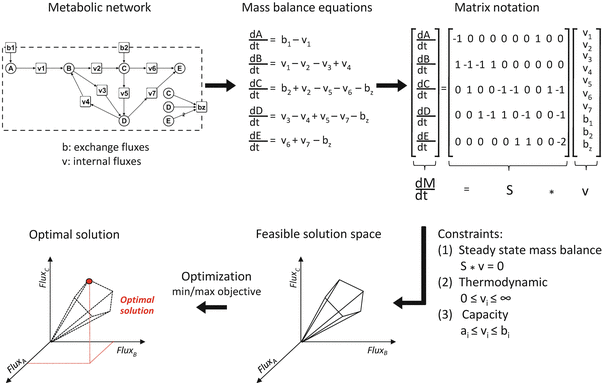Introduction
Project multidimesntional things in lower dimensions.
GeneSimRead: Can a biologist fix a radio? Or, what I learned while studting apoptosis by Yuri Lazebnik
Read: The evolution of molecular biology into systems biology: Westerhoff & Palsson
Read: D’Arcy Wentworth Thompson, one of the first persons to write a book on mathematical biology. The title is “On Growth and Form”.
Lookup: Macy Conferences
Andrew Huxley and Alan Hodgkin Made a neuron equivalent circuit that fits beautifully fits the data they aquired.
Read: The chemical basis of Morphogenesis: Alan Turning
A theory of biological pattern formation: Gierer and Reinhardt (1972)
Read: Models of Biological Pattern Formation by Hans Meinhardt
Flux balance Analysis (FBA)
- Exchange fluxes and Internal fluxes.

- Metabolic Control Analysis (MCA): All flux control coefficients must sum to the unit. The flux control coefficient of an enzyme is a system property and not a characteristic of the enzyme.
Modelling of Multicellular Systems
- Keller-Segal model for slime molds.
- Excitable Media:
- Hodgkin-Huxley model for neutron membranes is extremely complex. FitzHugh-Nagumo model is a simpler model.
Modelling insights into T cell development in the thymus
- Set of methodologies to assess progenitor/progeny relationships.
- Cre/Lox system: Cre is an enzyme. Insert somewhere…
- Cre is under the control of a promoter that is biologically relevant for the case-study
- Cre acticirt mediates the somatic recombination of a ubiquitously expressed reporter locus.
- Cells that have a history of Cre expression are fluorescently labeled.
- A population can be the direct progeny of another and only if the percentage of florescent cells in the progeny is at least as large as in the progenators.
- $p > d$ is equivalent to $d = p -a,\space a > 0$.
Systems Biology of Molecular and Cellular Networks
Cell cycle clock is coupled to the Circadian clock because of the common WEE1 expression, which is controlled by the circadian clock cycle.
In organolloids too, we see a circadian rhythm. The cells are not synchronous, but synchronous behaviour can be induced.
Feed-forward loops act as low pass filters.
flowchart LR X --> Y X --> XY Y --> XY XY --> ZAgeing correlates with protein aggregation in Yeast cells. During the cell division of yeast, the mother cells keep all the junk. And a few generations down, this waste builds up and the mother dies.
The cell cycle is also controlled by chaperones.
Food deprivation extends lifespans in general, if the organism is fully developed.
Predicting Protein Complexes
- Cytocast: a startup: Simulated cells to shape the future of medicine.
Boolean networks approach to systems biology
- State transition graphs (STG)
- Attractors: correspond to (biologically relevant) asymptotic behaviours
- Stable state: all gene levels are maintained. e.g. differentiated states, death,…
- Complex attractors: long-lasting oscillatory behaviour. e.g. cells
- Inherently Non-ergodic systems: will the initial state lead to the final state?
- GinSim: You can also annotate arrows with papers. www.ginsim.org/model_repository
- Stste transition graphs are not practical for most applications for addressing the complexity of current problems.
- Necessary condition for instability (or multi stability) is the ocorrance of a positive feedback loop in the regulatory network. Motifs for bistability:
Trap spaces: stable patterns/hypercubes, such that hypercube h: $$ \forall\cross h, f(x) \in h $$
Strongly Connected Components (SSC graph): Grouping a set of nodes into a high level node, when they form an orbit.
In the absence of kinetic knowledge, many alternative trajectories are possible.
Temporal Logic: Formalism for describing sequences of transitions between states in a reactive system
- CTL . Computational Tree Logic (branching-time)
- LTR - Linear Temporal Logic (linear-time)
- CTRL - Comutational Tree Regular Logic
Consortium for Logical Models and Tools
PhysiBoSS : Mechano-cell biology